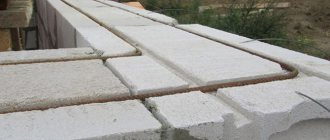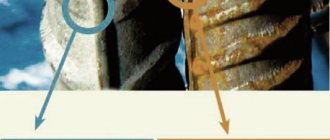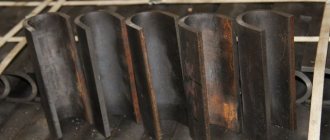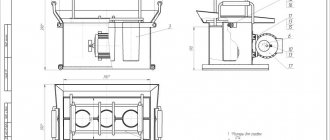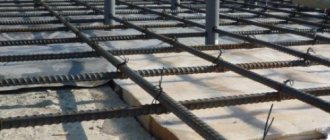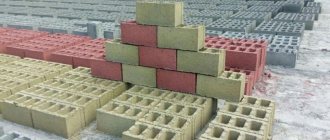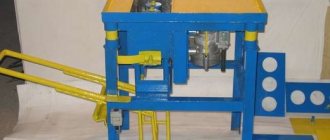Corrugated or smooth reinforcement is often used in the manufacture of reinforcing frames for foundations and other reinforced concrete structures.
Moreover, for the manufacture of metal frames, both straight and bent reinforcement bars are used.
If there are no problems with straight rods - I measured and cut them, then with bent rods you have to tinker. Of course, you can bend the reinforcement with your bare hands, but that’s if you do it too much.
In general, for these purposes, various machines and devices are used at home (popularly they are also called armagibs or simply benders).
In today’s article, we’ll look at several ways to make a homemade bending machine for reinforcement with your own hands.
We would like to immediately draw your attention to the fact that you cannot do without welding and a grinder.
Therefore, if you decide to make a bending device with your own hands, this tool must be at hand. And, of course, you need to know how to use it.
The correct reinforcement bender for yew trees
If you do not need a simple manual machine for bending reinforcement, but a universal device for performing various tasks, then pay attention to this design.
The idea and production of a homemade device belongs to the author of the YouTube channel “IGOR ANDREYCHUK”.
The practicality and functionality of a homemade device can be explained very simply - by using different equipment, you can perform different operations with metal.
The machine can not only bend reinforcement at right angles, but also make decorative curls and twist round steel bars.
The capabilities of this device can be seen in the photo below.
Bar winding
Making a curl
Let's now look at the main stages of manufacturing and assembling a homemade bending device.
Step one - we make the housing bearing.
To do this we need a bearing of a suitable size and a piece of pipe. We select a pipe of such diameter that the bearing fits freely into it, but the gap should be small.
Cut a piece of the required width from the round pipe. Using a grinder with a cutting disc, we make a cut in the wall of the ring.
We insert the bearing inside the ring and tighten the edges with a clamp. Then we scald it.
Step two - we make a seat in the bearing for installing the equipment.
From a metal corner 30x30 mm we cut two identical pieces. We apply them to a 30x30 mm profile pipe and scald them. We grind the corners with a grinder.
We insert the corrugated pipe with the corners inside the bearing, and weld the corners to the inner race. Then we remove the profile pipe and scald the upper part.
Step three - we make a handle with seats for the stop.
To make the handle of a bending machine, you can use a rectangular profile pipe. Cut a piece of the required length. The seats for the emphasis can be made from a round pipe.
We select a pipe of a suitable diameter, and then cut off six small pieces (barrels or bushings) from it. Then we weld them together.
The professional pipe handle must be attached by welding to the outer race of the bearing.
A previously made block of six bushings is welded to the side of the handle. Then the standard procedure is performed - cleaning the welds and the metal itself, and painting.
Step four - making a stop for the workpieces.
It's very easy to make. You will need a bolt, bearings and a nut. We insert the bolt into one of the seats on the handle, put bearings on it, and secure it with a nut.
Step five - preparing
a homemade bending device for work.
We install the equipment required for the job into the bearing (they are manufactured separately for specific needs). We clamp the lower part of the equipment in a bench vice.
Then, at the required distance from the equipment, we install a stop for the workpieces.
To bend the reinforcement you will need a lever handle. It can be made from rods of corrugated fittings, to the ends of which sections of corrugated pipe must be welded. We hammer the handle into the profile, welded to the outer race of the bearing.
You can also clamp the device itself in a yew. In this case, the lever handle will be inserted into a special attachment, which is installed on top of the equipment.
How to make a reinforcement bender with your own hands is shown in all details in the video below.
Reinforcement bender
Overall, the design turned out to be practical and functional. And the costs of time and materials for its production are quite adequate.
2 Devices for bending reinforcing bars
Over the history of the development of construction and metalworking technologies, humanity has invented more than one device for bending reinforcement. The principle of operation is the same for all, but the difference lies in the design of the equipment and the diameter of the bending reinforcement, depending on the model.
The part to be changed is fixed between the central and thrust roller (shaft) of the device. The third roller (bending) bends the metal in the desired direction to the required angle. Rounding can be done either clockwise or counterclockwise. An obstacle to deformation along the entire length is a thrust shaft, which does not allow the unused part of the workpiece to rotate or move.
There are two main equipment options:
- manual models;
- with mechanical drive.
Drive machines, except for special ones, operate according to the same scheme. The working body is a disk, which is mounted on a vertical shaft and rotates in a horizontal plane. The bending and central fingers are installed on the disk; reinforcement is placed between them. The thrust roller is fixed to the stand - the reinforcement rests against it when the disk rotates and bends around the central bushing under the action of a bending pin that moves along the outer surface of the rod.
The machines differ in power, productivity and are divided into 3 groups depending on their purpose:
- for light reinforcement – rod diameter 3–20 mm;
- heavy – 20–40 mm;
- super heavy – 40–90 mm.
Such a device for bending reinforcement is capable of bending several rods at the same time. Equipment for diameters 3–90 mm is also produced. If you need to make a complex structure with variable bending angles, then a hydraulic machine is best suited. It allows you to bend rods more efficiently, without the formation of kinks and folds on the surface of the workpiece that accompany metal stress. This machine can be used to bend at an angle of up to 180°.
The choice of bending equipment is determined by the diameter of the reinforcement and the volume of work. Before you start processing the metal, you should take into account that different parts of the rod are subjected to different stresses, the outer part is subjected to tension, and the inner part is subjected to compression. The wrong choice of machine or its illiterate use can lead to not only the appearance of folds and kinks, but also to damage to the reinforcement. Therefore, it is necessary to accurately determine all dimensions of the workpiece, appropriately configure the equipment and correctly fix the rod in it.
Do-it-yourself bending machine (rebar bender)
If your work requires a homemade desktop machine for bending reinforcement, we suggest adopting the idea of the author of the YouTube channel Fawa Bros.
This device can be used to bend corrugated and smooth reinforcement, as well as square bars.
Step one is making the base of the structure.
We will use a channel as a base. We cut the workpiece 35 cm long.
We install housing bearings on top of the channel, and use a marker to mark the locations for drilling holes.
After this, we drill holes and secure the bearings with bolts and nuts.
Step two is making a homemade bending mechanism.
On a lathe you need to turn a shaft with metal blanks at the ends. If you don't have a lathe, you can do it differently.
We cut two blanks of the same length from the steel round timber.
We drill blind holes at the ends of the workpieces. We insert pieces of a round rod of suitable diameter into the holes and scald them. Then in the blanks themselves you need to cut grooves for the reinforcement and square rod.
We insert two parts of the shaft into the holes in the housing bearings installed on the frame, and then weld them together.
We weld a long handle-lever made of a round rod to the central part of the shaft. A travel stop needs to be welded to it.
Step three - make an axle with support rollers
.
On the opposite side of the housing bearings, we weld an axle made of a round rod to the frame. We put on it two support rollers made of thick-walled round pipe.
To prevent the rollers from jumping off the axis during the bending of the reinforcing bar, washers must be welded along the edges of the rod.
The author solved this problem differently. First, he welded pieces of a metal strip with holes to the base (for fastening to the work table), then, along the edges of the axis, he welded pieces of a square rod that rest against the mounts.
Step four - installing a homemade handle stop.
You need to drill a hole in the base and weld a nut on the bottom. Then we screw a bolt into the nut, which will act as a stop to adjust the bend angle. We clean and paint the homemade product.
The completed structure can be mounted both on the table and on the floor in the workshop if you first drill holes in it and install mounting pins.
Instructions on how to assemble a compact machine for bending reinforcement with your own hands can be seen in the video below.
DIY tool | Make A Powerful Metal Bender for Construction Steels
The design turned out to be quite convenient for everyday use, and most importantly, reliable. The only difficulty may arise in the manufacture of the shaft.
How to bend reinforcement without a special device
Here it is worth knowing that when trying to bend, especially alloyed reinforcement, with your own hands you need to consciously calculate your actions, otherwise this can lead to serious injuries. Alloyed rolled metal, if you try to deform it, will try in every possible way to spring back and can cause irreparable harm to your health. So be careful and attentive.
Let us highlight the three simplest ways to bend reinforcement with a diameter of up to 8 mm yourself without the use of special devices, namely:
Using two pieces of metal pipe. So, we will need tubes with a diameter of 15 mm with a length of 0.5 and 1 meter, which we put on the fittings. We stand on a half-meter piece of pipe with our feet, and, accordingly, we begin to lift the meter piece to the bend angle we need.
- If a five-centimeter piece of pipe 25-32 mm in diameter is electric welded to a one and a half meter metal pipe of 32 mm in diameter or a 50 mm steel angle, you will get a universal bending lever. All that remains is to either stand on the reinforcement or rest it against something strong.
- Not very long pieces of reinforcement can be bent using a large vice and a sledgehammer. Only with this method you shouldn’t rush and you need to hit with a little force, stretching the process, otherwise you can simply break the reinforcing bar.
The main disadvantage of using such methods for bending reinforcement is that the turning radius is quite large and often the angle turns out to be somewhat curved and does not lie with its sides strictly in the same plane.
Reinforcement bender for home workshop
We bring to your attention another version of a homemade desktop device for bending reinforcement.
This idea was shared by the author of the YouTube channel Kwando Technic.
A square profile pipe measuring 50x50 mm is used as the machine bed. Cut a piece of it 80 cm long.
We also prepare two bearings and a piece of round pipe of a suitable diameter in order to then make a housing bearing.
At the end of the profile pipe we make a seat for installing a housing bearing.
Next, we manufacture the housing bearing itself. You will need to weld a lever from a square corrugated pipe to it.
In order to secure the frame to the desktop, it is necessary to weld metal plates with drilled mounting holes to its lower part.
On one side of the frame, the author welds metal plates to the mounting “feet”, between which a guide made of a round pipe will be attached.
At the next stage, we weld a piece of a corner to the frame, to which the workpiece stop is attached (we also make it from a corner, but we just need to cut the grooves for the bolts).
We install the guide in its place, having first put a pair of movable sliders on it. We weld the end stops to them.
Next, we proceed to assembling the reinforcement bending machine. We attach a housing bearing with a handle to the frame, and weld a pin to the handle onto which the thrust bearings are placed.
You can familiarize yourself with step-by-step instructions on how to make a desktop machine for bending reinforcement with your own hands, and also see the principle of operation of the device in the author’s video.
Homemade Metal Bending Tool | Making A Powerful Metal Bender
Compared to previous options, the design seems a little confused. But overall, it is quite functional.
How to create a homemade machine?
You can create a primitive machine yourself. To do this, you will need any pieces of pipe (thick) - they will act as a support and central roller.
Further:
- pipe sections are fixed in the soil or in a vice at the required distance;
- on the reinforcement that is to be bent, a larger piece of pipe is placed on top;
- begin to bend the rod, placing it between the “support” and “central” rollers.
It is necessary to additionally control the bend angle.
Important! To avoid injury during bending, work should be carried out in overalls and protective work gloves. You should not use adjustable wrenches or pliers to bend the rod, or perform jerking actions - this can lead to injury and damage the structure of the steel.
Bending machine from scrap metal scraps
You can make a simple reinforcement bender with your own hands even from unnecessary scraps of metal that are lying around in scrap metal.
A version of this bender design was shared by the author of the YouTube channel Fawa Bros. We will take this as a basis.
The first step will be to manufacture the moving part of the structure.
We cut out a blank of the required shape from sheet metal. Then you need to drill a hole and attach by welding a section of a pin onto which a thrust roller made of a round pipe is placed. Screw the nut onto the stud.
We weld the bearing to the bottom of the workpiece.
A metal plate of rectangular or square shape is suitable for the base - whichever you prefer.
We drill mounting holes in it in the corners, and another one closer to the central part.
We install a previously made part with a bearing on the plate, and fix it with a steel round timber, in the upper part of which there is a groove so that workpieces can be inserted.
The lower part of the round steel will need to be welded to the base of the reinforcement bender.
Next, we weld a piece of profile pipe to the moving part, onto which the lever handle will be placed.
We weld a piece of a square rod to the metal plate, on top of which we need to weld an elongated coupling. We screw a bolt into it, which in this case serves as a travel limiter for the moving part.
At the last stage, all that remains is to make the handle and install it.
The handle additionally has a movable stop, with which you can adjust the bending length of the workpiece.
How to make a compact device for bending reinforcement with your own hands is shown in all details in the author's video.
DIY Tool | Make A The Simplest Metal Bender | Homemade Metal Bending Tool
As in previous cases, the homemade product turned out to be simple and easy to use. The square plate is attached to the table using bolts, and you can immediately start working.
Reinforcement bending machines
According to the type of force with which the bending force is created, machines are classified into:
- manual,
- hydraulic,
- pneumatic,
- electromechanical,
- electromagnetic.
Using hand-held machines, it is possible to produce products from reinforcement with a diameter of up to 14 mm. If you need to manually bend reinforcement with a diameter of more than 14 mm. Then you should use the correct plate and a set of special keys. Manual production of curved reinforcing bars is advisable only for small volumes of work. Increasing the productivity of such manual labor is achieved by using machines for simultaneous processing of several reinforcing bars.
Other types of machines are distinguished by high productivity, precision of the manufactured configuration and the ability to bend reinforcement of any diameter. At the same time, they usually have various functions that increase productivity, small dimensions and the ability to operate in an automated mode.
Bending reinforcement using special equipment allows you to avoid twisting of the product around the central axis. In addition, products bent in this way are characterized by high accuracy of geometric shape. This achieves a reduction in time and labor costs for performing operations to install reinforcement parts in the required design position, which creates a positive economic effect on any construction site.
More information
When creating the structural frame of concrete work, bending and cutting of reinforcement (steel rods to strengthen the concrete) is very often necessary. It is an easy-to-work material that is often used in landscaping, art, and other projects that require metal that bends easily. Conventional reinforcement is distinguished by its nominal diameter, which varies in increments of 1/8 inch (that is, “number 4” reinforcement has a nominal diameter of 1/2 inch (15 mm)). Reinforcement up to number 4, as a rule, can be bent and cut by hand. Larger diameter rebar is not usually used except for technical or industrial concrete work and usually requires special equipment such as hydraulic shears and bending machines.
For this article, we will assume that 1/2 inch rebar (number 4) is used, which is common and used in landscaping and residential concrete work.
- Tight bends almost always require the use of a vise, jig, or special tool.
- The reinforcement can be heated with a torch for precise control of the bending process. However, this is unlikely to be needed when working with reinforcement having a nominal diameter of 1/2 inch (15 mm).
Powerful do-it-yourself reinforcement bender
This homemade product allows you to work with both corrugated and smooth fittings, as well as with corrugated pipes. Therefore, you can call it a pipe bender or a universal bender for the home workshop.
The author of the YouTube channel Kwando Technic shared how to make this device.
Necessary materials:
- channel;
- round pipe;
- Metal sheet;
- corner;
- steel round timber.
First we make the frame. For this we will use a channel. We decide on the length of the bed and cut the workpiece to the required length (80-90 cm will be enough).
We make homemade housing bearings and weld them to the frame. We install the steel shaft.
Additionally, the craftsman cuts off a piece of square rod and welds it in front of the housing bearings. It turned out to be a kind of small emphasis - just in case.
We cut out two narrow strips from sheet metal. We bend them like clamps and weld them to the frame and housing bearings.
At the next stage, we need to weld a shelf from a corner on the side of the bed, and attach a support roller next to it. We weld a fork to the end of the shaft for bending the workpieces.
Two handles must be welded on the opposite side of the shaft.
At the end, all that remains is to make a limiting stop to limit the stroke of the handle. To do this, cut off a piece of the corner, then weld it to the frame. First, drill a hole in the corner and weld the nut. We screw the bolt into the nut.
To attach the homemade product to a table or floor in the workshop, “feet” with holes need to be welded to the bottom of the frame. The final touch is sanding and painting.
You can watch how to make a device that bends reinforcement and corrugated pipe in the video on our website.
DIY tool | Homemade Powerful Metal Bender for Construction Steels
What rebar bending tools are available on the market?
The market offers household as well as industrial models of special bending equipment. Noteworthy is the Afacan manual reinforcement bender, offered in the following modifications:
- Afacan 10E. Works with rods with a cross section of 0.6–1.2 cm;
- Afacan 12E. Bends rolled products with a diameter of 1–1.2 cm;
- Afacan 16RT. Deforms rods with a diameter of up to 1.6 cm.
Manual universal benders are also offered, designed for bending reinforcing bars with a diameter of 0.6–2 cm.
Manual bending machines Afacan
It is possible to purchase or rent the following types of industrial bending plants:
- SGA-1. With an installed drive power of 3 kW, it easily deforms rods with a diameter of up to 3.2 cm, ensuring their bending by 160 degrees;
- GW-40. The design of the device with a three-kilowatt drive allows you to bend rolled metal products with a diameter of up to 4 cm by 180 degrees;
- G-40. The kinematics of the device, equipped with a step transmission mechanism, allows you to repeatedly deform a rod with a cross-section of up to 3.2 cm;
- G-50. This industrial installation, equipped with a 4 kW drive station, deforms reinforcing bars with a diameter of up to 5 cm.
When deciding to purchase bending equipment, consult with specialists. They will give professional advice and help you choose the right device depending on the tasks at hand.
Rules for maintenance and operation of the machine
A hand-made machine for bending a rod is no different in design and functionality from a factory-produced model.
Based on this, this equipment should be handled in accordance with the current operating rules.
The person who will perform metal bending operations must be trained in how to operate the machine.
The workplace must be equipped in such a way that the original workpieces are fed from one side, and the finished part is laid on the other.
Littering of the area adjacent to the machine is not allowed.
Preparation of materials and tools
Before making a bending machine, read the available drawings or make your own. The thickness of the reinforcing rod and their number are important as initial data. The safety factor of the device, which exceeds the effort required to bend the existing reinforcing bars, is chosen to be at least three times larger if the business is put into production and you are bending reinforcement for a large number of customers, or a grandiose construction project is planned.
If the drawing is selected, the following tools and accessories will be required.
- Grinder with a set of cutting and grinding discs. Without it, sawing a massive profile and reinforcing bars is difficult.
- Electric drill and suitable high-speed steel drill bits.
- Welding installation and electrodes.
- A hammer, a sledgehammer, powerful pliers, a chisel (file), a center punch and several other tools that no mechanic can do without.
- Vise for workbench. Since the structure is powerful, it must be fixed.
The materials you will need are:
- corner profile (25*25 mm) 60 cm long;
- steel rod (diameter 12-25 mm);
- bolts 2*5 cm, nuts for them (20 mm in inner diameter), washers for them (can be screwed).
If a bar bender is made on the basis of another device, for example, a jack, then such a device must be present.
The device you will make weighs more than one kilogram. The reinforced weight and massiveness of the entire structure will provide the strength required for bending the reinforcement.
The principle of bending reinforcement
The principle of operation of the bending machine is based on the fact that the reinforcement is firmly fixed (one or two ends) and, when pressed by the operator, reinforced by a lever or a system of levers, it is bent at the desired angle.
According to building codes, the bend angle of the rod must be such that the concrete in the finished reinforced concrete product is not damaged or crumbled at the bend site. The bending of the rod along a notch or under the influence of elevated temperature is not allowed - this will reduce the strength characteristics of the rod, and, as a result, the future structure. Reinforcement can only be bent “cold”. The simplest bending machine consists of two angles connected by a bolt. In the simplest, but not the most reliable, version, they don’t even need to be welded together.
Performing a bend
When bending, you must comply with construction regulations for a specific type of reinforcement: for example, the permissible bend angle A-III is 90 degrees, provided that the bend radius is not less than 6-8 rod diameters. If the reinforcing bar is bent by 180%, the strength will decrease by 10%.
